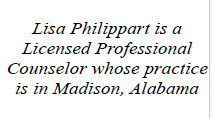In my last article, we decided that you were going to seek help by making an appointment to see a mental health professional. I shared how to search for a therapist, and also looked at resources to find the right fit for you. Once you have chosen a therapist, it’s time to schedule that first appointment. I have had so many first-time clients voice such thoughts as, “I was so nervous…I just didn’t know what to expect,” or “Wow. This wasn’t at all what I thought it would be,” or “I wish I would have come sooner.” Whatever is going through your head, I can help you to be a little bit better prepared, which may serve to allay some of your fears or concerns.
 Many therapists now have websites, which not only provide a wealth of information about who they are, but also contain the forms that they use for their practice. If these forms are available on the website, the therapist will most likely ask you to print out and complete this paperwork. The forms are usually an intake questionnaire, informed consent, and an authorization to release information. The intake can be overwhelming because we want and need to know about your past and current situation. Some of the questions may seem extremely personal and even hurtful. The important piece to remember is be honest. I can’t help you if the person on the paper doesn’t match the person in front of me. If you don’t feel comfortable answering a particular question, then don’t. That’s right, don’t. Intakes can be invasive and triggering. So maybe you just aren’t ready to “share” before you have even met your therapist. I understand. Either leave the answer blank or write “not ready to go there.” At my client’s first session, I ask if she would like to take some time to review her information, or do we need to go right to what brought her in to my office. Remember this is your time. The counseling session is about you.
Many therapists now have websites, which not only provide a wealth of information about who they are, but also contain the forms that they use for their practice. If these forms are available on the website, the therapist will most likely ask you to print out and complete this paperwork. The forms are usually an intake questionnaire, informed consent, and an authorization to release information. The intake can be overwhelming because we want and need to know about your past and current situation. Some of the questions may seem extremely personal and even hurtful. The important piece to remember is be honest. I can’t help you if the person on the paper doesn’t match the person in front of me. If you don’t feel comfortable answering a particular question, then don’t. That’s right, don’t. Intakes can be invasive and triggering. So maybe you just aren’t ready to “share” before you have even met your therapist. I understand. Either leave the answer blank or write “not ready to go there.” At my client’s first session, I ask if she would like to take some time to review her information, or do we need to go right to what brought her in to my office. Remember this is your time. The counseling session is about you.
 Informed consent is letting you, the client, know that you have the legal and ethical right to understand and agree to the proposed “relationship” to which you are entering. The consent contains information about practices, procedures, and methods. There are usually sections about cancellations, risks and benefits, termination, social media restrictions, financial arrangements, arbitration, communication techniques, and patient’s rights. Your most important right is found in the confidentiality statement, which lets you know that what is discussed in session remains private, except for certain safety issues, which include harm to self or others, and elder or child abuse. Your privacy is critical because you need to know that you can be free to express yourself without fear of judgment. The authorization to release information form is used only if you are willing to allow others to have access to the information in your file.
Informed consent is letting you, the client, know that you have the legal and ethical right to understand and agree to the proposed “relationship” to which you are entering. The consent contains information about practices, procedures, and methods. There are usually sections about cancellations, risks and benefits, termination, social media restrictions, financial arrangements, arbitration, communication techniques, and patient’s rights. Your most important right is found in the confidentiality statement, which lets you know that what is discussed in session remains private, except for certain safety issues, which include harm to self or others, and elder or child abuse. Your privacy is critical because you need to know that you can be free to express yourself without fear of judgment. The authorization to release information form is used only if you are willing to allow others to have access to the information in your file.
The first session is usually spent information-gathering, and the therapist may need to ask LOTS of questions. During that initial session most therapists alternate between directive and non-directive therapy. For example, if you have a hard time opening up and/ or getting started, I may need to take the lead and explore through my inquiries. I have had other clients walk into that first session and they don’t stop talking until the hour is up! These clients are often the ones who have waited way too long to come see me and can’t wait to just “spew.” After your session, take some time to reflect. Ask yourself: Is this someone who can help me? Do I feel comfortable sharing the most intimate parts of my life with this person? Did they seem genuine and caring?
I will come full circle in my next article and address how a counselor could help you to change unhealthy relational patterns.
By: Lisa Philippart
Licensed Professional Counselor








